Discover how Digital Twin of Customer software is transforming business strategies in 2025. Learn how AI-powered customer twins enable hyper-personalized engagement, marketing precision, and 360-degree view of the customer.
Imagine losing a loyal customer not because of poor service, but because your competitor understood them better. This has become quite ordinary in 2025. The Digital Twin of a Customer is a clever, data-driven strategy that is driving businesses’ constant transition from reactive service models to proactive customer interaction.

Using both historical and real-time data, the Digital Twin of a Customer (DToC) is a dynamic digital representation of a person. It captures habits, preferences, interactions, and even mood, giving businesses a deeper understanding of each individual.
Because companies can use these digital twins to simulate and test different customer experiences before rolling them out, they can identify the most effective approaches in advance. This enables them to engage and communicate with customers in a way that feels more relevant, timely, and successful.
As Gartner predicts, by 2025, more than 60% of the large organizations will employ digital twins to seamlessly enhance customer experience and performance.
With technology evolving each passing second, DToC has become essential. It is a true game-changer, from enabling AI-powered customer journey mapping to forecasting customer personalizations. Let’s examine the implications of this breakthrough for companies in 2025.
Meaning: Digital Twin of a Customer (DToC)
Consider it your digital doppelganger. A Customer Digital Twin is a virtual representation of an actual customer, that is frequently updated with real-time data. This isn’t only about knowing your customer’s age or purchase history, it’s about understanding what drives them, what they might want next, and how they prefer to engage.
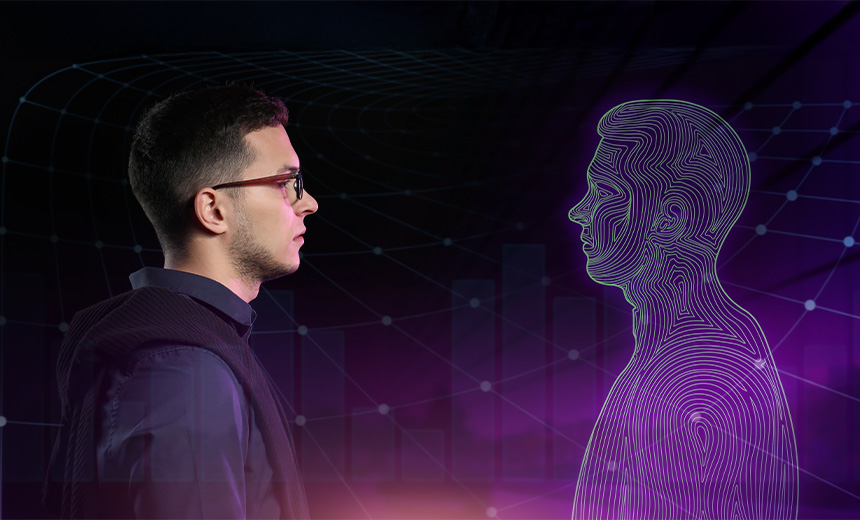
Main Components:
- Demographics: Age, location, income, profession
- Behavioral Data: Click patterns, purchase frequency, engagement metrics
- Preferences: Channel choices, product interests, language tone
- Contextual Inputs: Time, place, and device used
- Emotional Indicators: Sentiment derived from VoC and behavioral cues
The AI customer twin concept was initially used in manufacturing and later adopted in healthcare. Today, it’s enhancing customer-centric industries like retail, finance, and telecom.
How does Digital Twin of Customer software work?
The power of Digital Twin of Customer software lies in its ability to collect, process, and interpret complex data layers.
Technologies Used:
- AI & Machine Learning: Enables pattern recognition and behavior prediction
- IoT Devices: Capture user data in physical environments
- CRM & CDP Systems: Store and organize customer insights
- Advanced Analytics: Translate raw data into actionable intelligence
Data Sources:
- Website and app activity
- Social media engagement
- Customer support conversations
- IoT-enabled product usage
- Purchase history
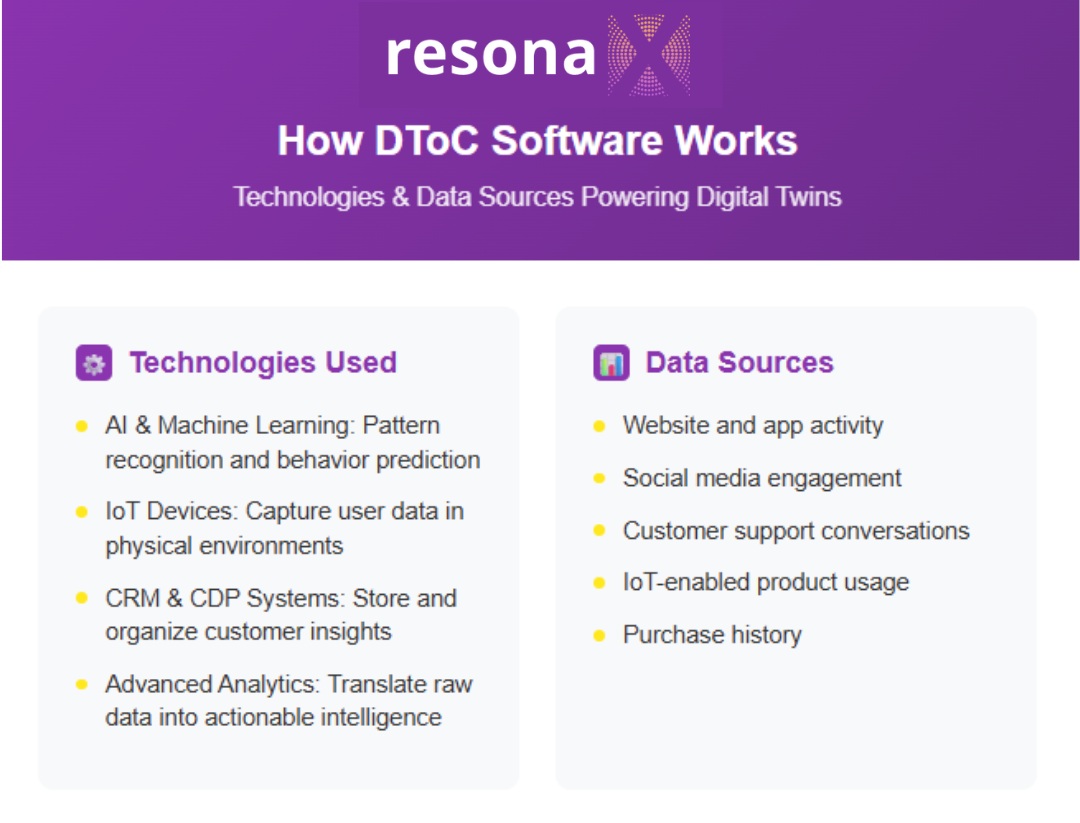
You must have heard of the q-commerce platform Blinkit. If a user often orders snacks late at night, the customer digital twin can prompt timely offers or even pre-fill carts based on predictive patterns. This real-time syncing translates into ultra-fast service, increasing customer satisfaction and retention.
Elevating modern marketing with Customer Digital Twins

Why should marketers care? Customers of today demand the excitement in addition to customization. Beyond conventional targeting, Digital Twin for Marketing develops into a strategic engine for accuracy, speed, and relevance.
Marketers can obtain a real-time, dynamic perspective on individual motives and actions by utilizing AI-powered consumer twins. This is how it changes the efficacy of marketing:
- 360° Customer Understanding: Gain a comprehensive, up-to-date understanding of how customers behave across all touchpoints, which is crucial for developing seamless omnichannel experiences.
- Predictive Journey Mapping: Map a customer’s probable path as well as their current location. Forecast intentions and proactively adjust paths to meet future demands.
- Emotion-Led Campaigning: Increase empathy and engagement by matching messaging to the customer’s emotional state using sentiment and mood analysis.
- Real-Time Testing & Iteration: Before launching, use live consumer avatars to test marketing campaigns or offers in controlled, data-driven environments. This reveals exactly what will resonate with your audience, allowing you to fine-tune messaging for maximum impact and ultimately boost conversions while reducing uncertainty.
- Dynamic Segmentation: Forget about static demographics with dynamic segmentation. For hyper-targeted outreach, group clients according to their preferences, context, and behavior in real time.
- Creative Optimization: Before going live, A/B test different creative elements on digital twins to see which ones work best.
- Channel Preference Insights: To maximize effect and minimize friction, know exactly when, where and how each consumer prefers to be engaged.
- Feedback Loop Integration: Continuously improve brand positioning and message by gaining actionable data from virtual engagements.
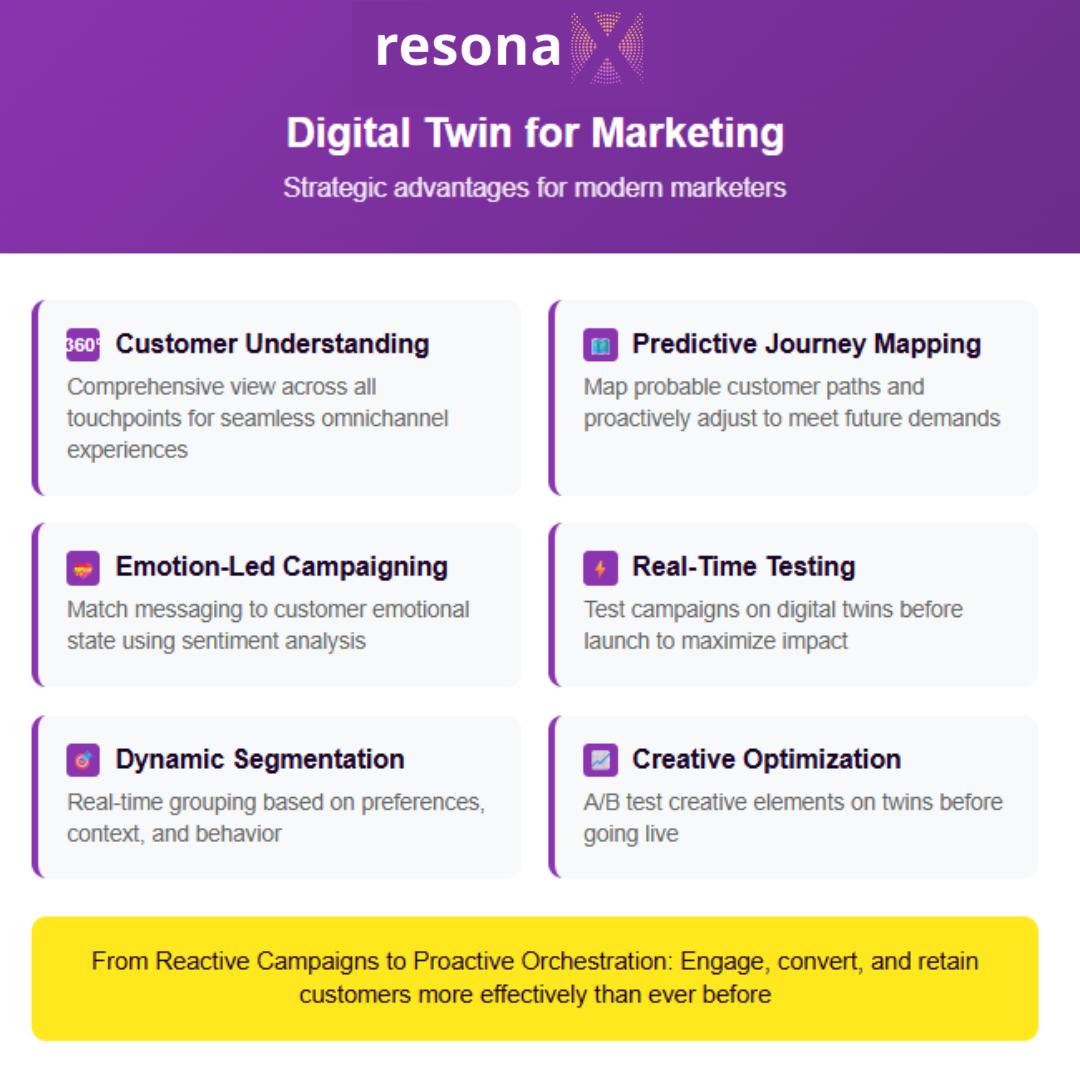
In short, Customer Digital Twins allow marketers to go from reactive campaigns to proactive orchestration, enabling them to engage, convert, and keep customers more effectively than ever before.
As per an MIT Sloan report, Starbucks once used predictive analytics and AI customer twin to customize their promotions as per local weather, past preferences, and time of day, and saw a 3x improvement in engagement. If Starbucks can, why not you?
Why DToC is business-critical in 2025
In 2025, personalization isn’t optional, it’s expected. Customers want brands to understand them without asking too many questions. This is where Digital Twin of Customer steps in.
The impact across departments:
- Marketing: Marketing teams may create dynamic, personalized content that instantly connects with consumers by using digital twin technology to implement micro-segmentation tactics, testing their content instantly with digital twins of customers to identify what resonates best and refine it in real time.
- Sales: Sales teams may create highly customized pitches that boost conversion rates and build trust by using insights from AI customer twins to assess prospects more precisely.
- Support: Customer service teams benefit by accessing predictive data that allows them to proactively address issues, sometimes even before a customer raises a concern, thereby reducing frustration.
- Product Design: Digital twin technology provides continuous feedback to product development units, enabling real-time innovation and modifications based on changing customer preferences and experiences.
DToC in action: Real industry applications
Let’s examine in more detail how companies in various industries are using Digital Twin for Marketing to improve customer satisfaction and operational transformation:
- SaaS: In the competitive SaaS market, businesses are using Digital Twin of Customer software to improve product engagement, anticipate attrition, and personalize onboarding. SaaS providers may create intelligent AI customer twins that guide roadmap decisions, automate upsell tactics, and give customized experiences by examining in-app activity, use trends, and support interactions. Today, implementing a Digital Twin of a Customer is not only advantageous but also becoming necessary for SaaS models to scale growth and retention.
- Retail: AI-driven customer twins are used by companies such as Sephora to comprehend consumer preferences, buying patterns, and even skin types. This makes it possible for businesses to recommend highly customized beauty routines, increasing customer happiness and increasing in-store and online conversion rates.
- Banking: Digital twin technology is used by financial institutions like HSBC to track transactional activity and identify irregularities instantly. This helps avoid fraud and offers highly customized financial advise based on spending habits and objectives.
- Healthcare: To model medical treatments, anticipate relapses, and improve treatment plans, institutions such as the Cleveland Clinic are building digital twins of their patients. Better results and preventive care are guaranteed when AI-powered customer journey mapping is used in the healthcare industry.
- Telecom: Vodafone offers data plans dynamically depending on client interactions and use patterns by using customer twins. By automating support resolutions, the twin lowers downtime and improves user happiness.
- E-commerce: To improve recommendation engines and provide a more engaging and user-friendly purchasing experience, businesses such as Amazon are investigating DToC. They can better manage inventory, anticipate requirements, and personalize interfaces with the aid of digital customer twins.
- Hospitality: Major hotel chains are testing DToCs to offer concierge-style digital assistants that learn from past visits. From preferred room temperature to favorite cuisines, these insights enhance the overall guest experience.
Such early adopters of Digital Twin for Marketing are not just investing in data, they’re also investing in long-term loyalty.
The clear wins of going Digital Twin
Before diving into a list, here’s the big picture: DToC means smarter decisions and deeper relationships. It’s not just about efficiency, it’s about empathy powered by data.
By using digital twin technology, companies are anticipating client requirements, producing better experiences, and building enduring emotional bonds rather than merely meeting them.
Scalable personalization is the benefit. Customer digital twins allow brands to act with surgical precision, whether it’s creating a new product based on predictive data or sending a personalized offer at the ideal moment.
This improves overall business performance and reduces unnecessary marketing expenditures. Additionally, by giving cross-functional teams—marketing, sales, product, and service—a common understanding of the consumer, DToCs promote more cohesive and successful initiatives.
By embedding intelligence into every stage of the customer lifecycle, companies unlock a proactive ecosystem, one where CX isn’t a reaction, but a design. Brands can test ideas, validate experiences, and make changes faster than ever before. And in a world that rewards relevance and speed, that’s a massive competitive edge.
Importance of Digital Twin Technology:
- Higher customer satisfaction and long-term brand loyalty
- Enhanced customer lifetime value (CLV) through targeted interventions
- Improved Voice of the Customer (VoC) analysis to uncover deeper sentiments
- More efficient sales cycles and smarter lead qualification
- Elevated return on marketing investment (ROMI) due to better targeting
- A consistent, always-updated 360-degree view of the customer
- Agile customer experience (CX) design driven by real-time insights and feedback
Overcoming the Challenges
As with any emerging tech, the journey isn’t free from bumps while using customer digital twins. But with proper frameworks, these can be managed effectively.
Some common hurdles include:
- Data Privacy & Ethics: Must comply with GDPR, CCPA
- Legacy System Integration: Requires modern infrastructure
- Data Accuracy: Inconsistent or poor-quality data limits performance
- Organizational Resistance: Change management is essential
Pro Tip: Ethical AI governance and robust compliance models will be key differentiators.
What’s Next for Digital Twins of Customers?
As AI matures, so does the scope of digital twins. In 2025 and beyond, more human-like interactions and automation is expected.
Future Trends:
- Integration with Generative AI: Enabling voice-led, natural interactions
- Virtual Reality CX: Immersive, emotion-based brand experiences
- Autonomous CX Engines: Real-time decisions without human intervention
Imagine talking to your customer twin through a VR headset and testing a new product pitch. This is the future with digital twin technology, and it is now.
How resonaX.ai Helps in Smarter Marketing with DToCs
Think of having an AI-powered version of your ideal customer, someone who thinks, reacts, and makes decisions just like the real people you want to reach. That’s exactly what resonaX.ai delivers.
Our platform builds hyper-realistic Digital Twins of your target customers, combining demographic, behavioral, emotional, psychological and contextual data to create accurate simulations of how they browse, decide, and buy.
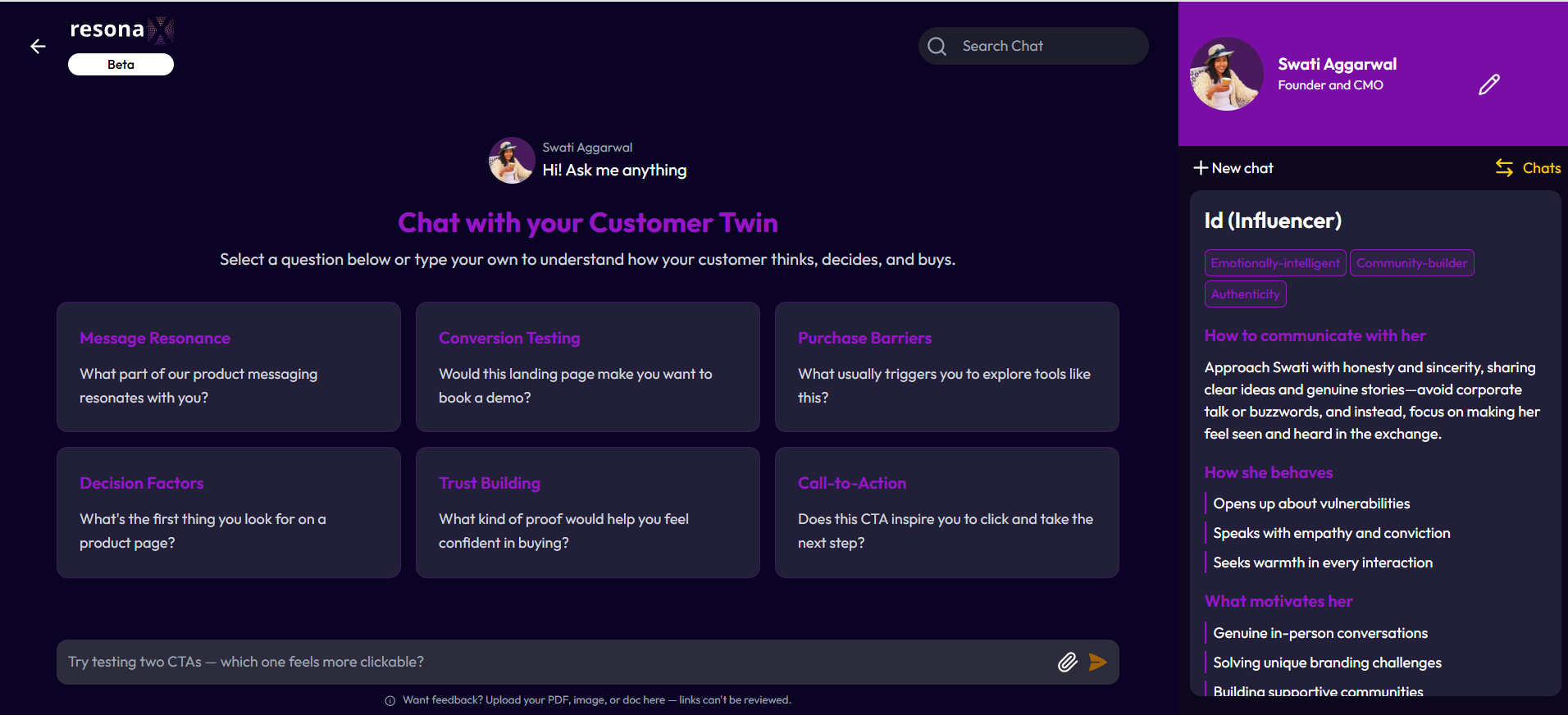
With resonaX.ai, marketers don’t have to guess what might work, they can test every marketing asset in advance:
- Campaign messaging and visuals
- Webpage layouts and CTAs
- Social media posts and ad creatives
- Email subject lines and content flows
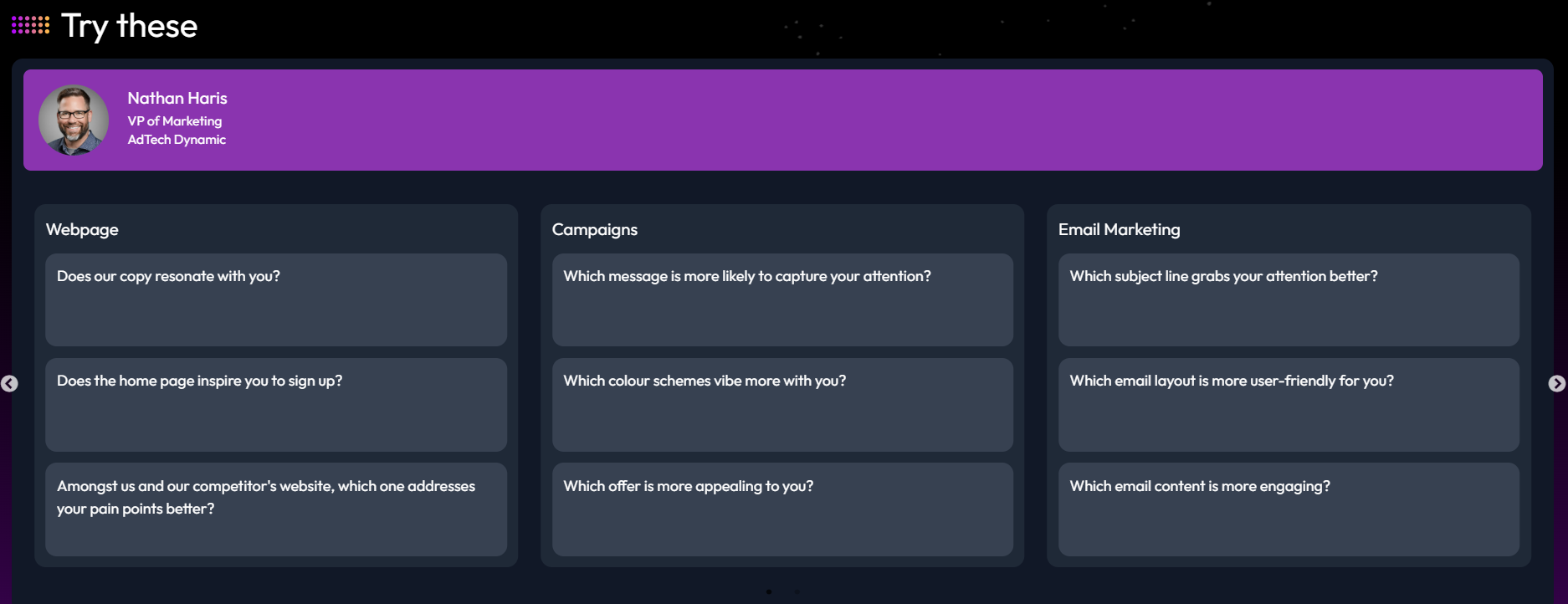
These customer twins respond in real time, revealing what resonates, what’s ignored, and what drives conversions, before you spend a single dollar on actual deployment.
By integrating AI-powered customer journey mapping, Voice of the Customer (VoC) sentiment analysis, and 360-degree customer views, resonaX.ai transforms raw audience data into actionable, proven strategies. The result? Campaigns that land better, faster, and with far less risk.
Do you want to discover what motivates your audience to buy? When should you get involved? Which channel will get the best response from them? resonaX.ai is here to answer all your questions.
How resonaX.ai Turns Customer Insights into Converting Experiences
resonaX.ai is built for marketers who refuse to rely on guesswork. Instead of launching campaigns and hoping they connect, our platform lets you talk directly to the AI-powered Digital Twins of your best customers, anytime, anywhere.
Using your real customer data, resonaX.ai creates hyper-realistic AI personas that think, react, and decide exactly like your most valuable customer. Segments (delete this word)
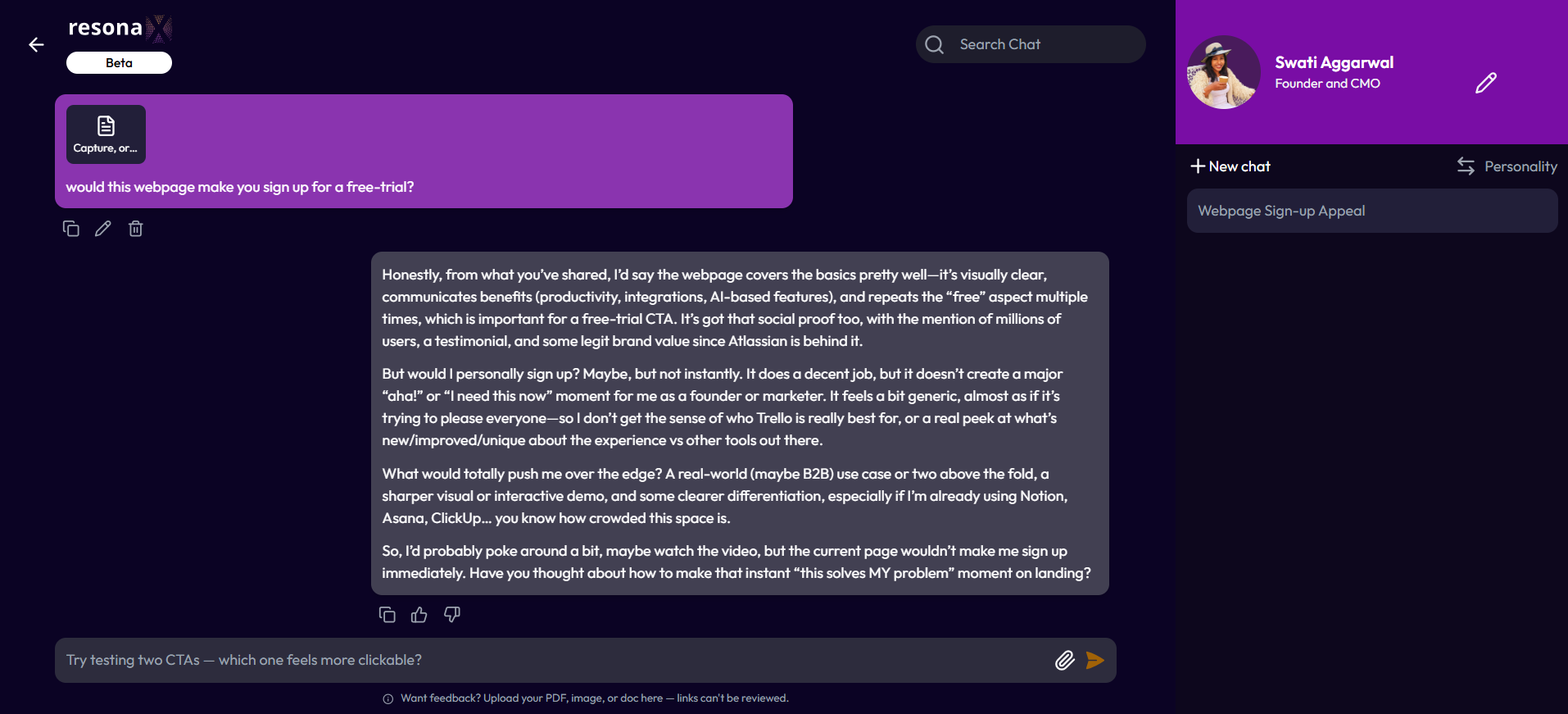
This always-on “focus group” gives you unfiltered, instant feedback, so every marketing decision is backed by proof.
In 2025, Digital Twin of a Customer technology is the difference between reaching your audience and truly resonating with them. With resonaX.ai, you launch campaigns already fine‑tuned to what your customers will love, because you’ve tested it with them first.
Final Remarks
Understanding and adopting Digital Twin of a Customer 2025 isn’t just about keeping up with trends. It’s about gaining a meaningful edge in a customer-driven economy.
If you’re a business leader, ask yourself: Are we ready to meet our future customer where they are, or will we be left behind?
Take the First Step: Explore how resonaX.ai can help create, manage, and scale your marketing strategy. From integration to analytics, make every message more relevant, resonant, and impactful. Contact us today!
Frequently Asked Questions (FAQs)
- What is a Digital Twin of a Customer (DToC)?
A Digital Twin of a Customer (DToC) is a dynamic digital model of an individual customer, created using behavioral, transactional and collected data to help businesses, especially marketers, to understand their customers better, and get actionable results.
- How is DToC different from a traditional customer profile?
Unlike traditional static profiles, a Digital Twin of a Customer (DToC) updates in real time and uses AI to predict behavior, by providing a virtual replica of the customer. DToCs evolve with every interaction, providing marketers with deeper insights and hyper-personalized recommendations.
- How is AI used in a Digital Twin of a Customer?
AI helps a Digital Twin of a Customer decode behaviour, find patterns, and deliver personalized recommendations based on real-time data. For marketers, it means better engagement, personalization, and results.
- Can ChatGPT or similar AI models be used with a DToC?
Yes, AI models like ChatGPT can enhance interaction and customer understanding in DToC ecosystems.
- What data is required to build a DToC?
A DToC requires web activity, CRM records, purchase history, support interactions, social interactions and IoT data to build.
- Is a DToC GDPR/CCPA compliant?
Yes, a DToC can be compliant if companies ensure transparent data usage, obtain proper consent, and follow all privacy regulations strictly.
- What are the use cases of DToC in business?
Digital Twin of Customer technology lets businesses test and refine campaigns, optimize customer experience, predict sales, and guide product innovation using AI-driven replicas of ideal customers for data-backed, resonant marketing decisions.
- How does DToC impact customer experience (CX)?
Digital Twin of Customer technology improves CX by predicting customer needs, enabling marketers to test and refine interactions beforehand, and delivering highly personalized, seamless experiences that increase satisfaction and loyalty.
- What industries are using DToC with AI?
SaaS, retail, finance, telecom, healthcare, and e-commerce.
- Can a DToC be used to simulate future customer scenarios?
Yes, it can simulate various responses and behaviors to help design better strategies.
- What technologies are driving the development of customer digital twins in 2025?
AI, machine learning, IoT, cloud computing, and advanced analytics.
- What challenges might organizations face when creating and using digital twins of customers in 2025?
Organizations may face challenges like data privacy concerns, integrating with existing systems, ensuring data accuracy, and managing internal change, but with the right strategy and tools, these hurdles can be successfully overcome.
